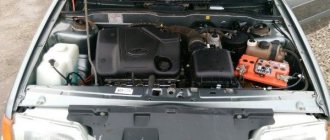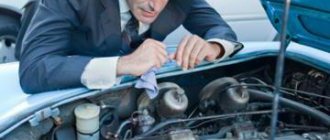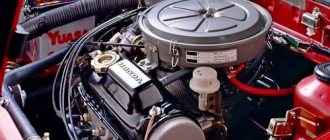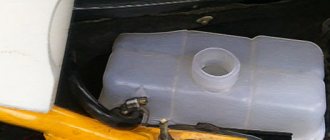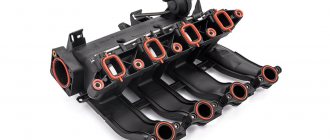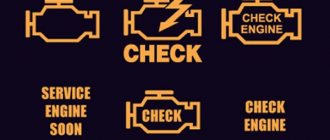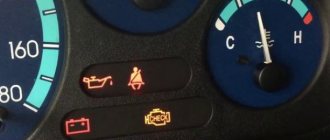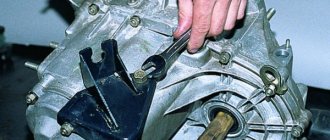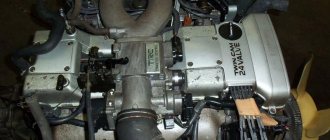How to check injection nozzles without removing them from the engine
Malfunctions of the injector (nozzles) occur on both diesel and gasoline engines.
In the design of the power supply system of an injection engine, the nozzle is an element that is responsible for injecting a sprayed portion of fuel into the combustion chamber under a certain pressure. Precise dosing, tightness and timely operation of the injection nozzle ensure stable and proper operation of the engine in all operating modes. If the injector “flows” (passes excess fuel at a time when its supply is not required), the efficiency of fuel atomization decreases (the shape of the torch is disrupted) and other injector malfunctions occur, then the engine begins to smoke gray or black smoke, loses power, consumes a lot of fuel and etc.
Causes and troubleshooting of the injection system of an injection engine
The injection mechanism is an element of the car's fuel system, which forms a fuel-air mixture. Modern cars use a fuel injection system with direct injection into the engine cylinder. Let's look at the main causes of injector malfunction and options for eliminating them.
Engine won't start
- The causes of the malfunction may lie in problems with the electric fuel pump; it is necessary to check the voltage supply to the pump and the electrical contacts for sufficient conductivity.
- Another possible reason may be the absence of a signal from the shaft speed sensors and the Hall sensor; therefore, to eliminate this, you should check the electrical wires and interrogate the memory device to determine faults.
- Defective fuse, fuel pump relay and defective valve injectors.
A cold engine starts hard or runs rough.
Most likely the problem is a defective temperature sensor. To fix it, you need to check the coolant and intake air temperature sensors.
The engine stalls.
- Temporary faults in the electrical connection of the fuel pump. It is necessary to check the plug connectors and connections of the electrical wires to the fuel pump, inspect the fuse and the contact points of the fuel pump relay. The contacts will need to be cleaned or replaced.
- Low fuel pump performance.
- Fuel filter clogged. To fix this, you need to replace the fuel filter.
- Defects in the fuel pump and valve injector.
Malfunctions in engine operation at idle and during transient processes.
- Intake system leaking. To eliminate it, you need to check the seals and connections in the intake system.
- Leakage of the power supply system. You should inspect all areas in the area of the engine and fuel pump and tighten all connections.
- Temperature sensor malfunction. It is necessary to check the coolant and intake air temperature sensor.
A hot engine will not start.
- The source of the problem may lie in high fuel pressure in the system. It is necessary to check the fuel pressure and, if necessary, replace the pressure regulator.
- The fuel return line between the pressure regulator and the fuel tank is clogged or pinched. To eliminate the malfunction, the fuel line must be cleaned or replaced.
The engine runs after the ignition is turned off.
Most likely the problem is a leaky injector valve, which needs to be checked.
Which indicates possible problems with the injector
Let us immediately note that there can be many reasons for unstable engine operation, ranging from a clogged fuel filter, a broken fuel pump, a failed spark plug or a faulty coil, to loss of compression, problems with the timing belt, etc. Along with this, one of the main signs of injector malfunction is difficulty starting the engine, especially when cold, as well as gasoline or diesel consumption (depending on the engine type), which increases noticeably. It is also necessary to note the unstable operation of the internal combustion engine in idle mode, similar to the so-called “triple” of the engine.
When driving, it is possible that one or several symptoms may occur quite frequently:
- presence of jerks, very slow reactions when pressing the gas pedal;
- obvious failures and loss of dynamics when trying to accelerate sharply;
- the car may jerk while driving, when releasing the gas, and also after changing the load mode on the engine;
It must be added that such a malfunction must be corrected immediately, since problems with the injector negatively affect not only the service life of the engine and transmission, but also overall traffic safety. In a vehicle with faulty injectors, the driver may experience serious difficulties when overtaking, on steep hills, etc.
Malfunctions and repair of injection engine
Not so long ago, all engines were divided into diesel and carburetor. Diesel ones are those that run on diesel fuel, and those that run on gasoline are called carburetor ones, since carburetors were installed on them. But now cars are equipped with new generation engines - i.e. injection, which is what most car enthusiasts choose. Let's talk about malfunctions and repairs of an injection engine.
Malfunctions and repair of injection engine
Malfunctions and repair of injection engine
Although the engines are of a new generation, they still require maintenance and repair issues have not decreased. When a malfunction occurs in an injection engine in the city, there are no particular difficulties with repairs.
Undoubtedly, internal combustion engine repair https://dvigatel-msk.ru/ should be entrusted only to professionals!
But if the engine malfunctions on the road far from populated areas with service stations, then the car enthusiast himself will have to fix the injection engine, from diagnostics to repair.
The fuel pump can cause serious problems. In engines with an injector, an electric pump operates, which is installed mainly in the fuel tank. In engines with a carburetor, a fuel priming diaphragm pump is installed. If gasoline can be supplied to the carburetor manually, then if the electric fuel pump fails, the car will have to be towed.
When you turn on the ignition in a car with an injection engine, the car owner hears the whirring of the pump in the gas tank, which creates pressure in the fuel system of the car. If the sound comes from the gas tank with a different intonation, intermittently, then it is better not to go on a long journey, but to go and check the electric fuel pump.
In order for the electric fuel pump to work for a long time and without problems, you need to refuel with high-quality gasoline and periodically change the fuel filter. When water and dirt get into the pump, the electric motor of the pump quickly burns out. The electric motor of the pump heats up during operation, and gasoline cools it. But if the fuel level in the gas tank is low, the pump will fail due to overheating. When you have a trip to the mountains with a long climb, the gas tank needs to be filled completely.
An engine with an injector often has problems with idling (idling), and the engine begins to run intermittently at low speeds and does not start on the first try. In this case, it is necessary to clean the XX channels, since if the air supply regulator is not functioning properly, it is difficult to diagnose unstable engine operation. You might think that poor XX performance is not such a big problem, you just need to get on the highway and this system will not be needed, since the car will be moving at high speed.
But by the time the driver gets to the highway, especially in a big city, the engine will stall at traffic lights and in traffic jams. Frequent and long starts of an injection engine will quickly drain the battery and the driver runs the risk of not being able to reach the country road. And at traffic lights the driver will have to listen to a lot of unpleasant things about himself, since the engine will not start on the first try. And the reason for everything will be a faulty XX system and an engine overheated in traffic jams.
An engine with an injector, like any other, needs a well-functioning cooling system. Therefore, if the cooling radiator is clogged on the outside with dirt or midges, then air will not pass through it well, and the engine will overheat, which can lead to its breakdown. To clean the radiator, you need to rinse the radiator honeycombs with a jet of water under pressure and get rid of external contaminants. Leaking coolant from the radiator can also lead to overheating. If this malfunction occurs, you need to go to a specialist and eliminate the leak.
There are times when the antifreeze temperature measurement sensor in the cooling system burns out, which happens in hot weather. In this case, the car's computer does not receive data on the temperature of the coolant in the injection engine, considering the temperature optimal, and does not regulate the ignition. If the ignition is set incorrectly, the injection engine will operate with detonation and this will lead to a decrease in power. Therefore, the health of the sensor must be constantly monitored.
If, however, the engine overheats, you need to stop and turn it off. After this, you need to relieve the pressure in the cooling system by unscrewing the valve plug from the expansion tank. All manipulations must be done carefully. First, you need to throw a rag over the plug so that when you unscrew it, the released steam and hot liquid, splashing from under it, do not get on the driver. Then you need to unscrew the plug very slowly and carefully, since under the influence of excess pressure it can be torn off the thread, and a fountain of hot steam with antifreeze, if it gets on a person, can cause injury in the form of a thermal burn.
Read about injector flushing HERE.
By preventing the injection engine from overheating, the car enthusiast will save himself from material losses, and the engine from expensive repairs.
The principle of operation of an injection engine video:
Did you like the article? Share with your friends on social networks!
Self-check of injectors
Let's start with the fact that automobile injectors are divided into several types, of which two types have found widespread use at different times: mechanical injectors and electromagnetic (electromechanical) injectors.
Electromagnetic injectors are based on a special valve that opens and closes the injector to supply fuel under the influence of a control pulse from the engine ECU. Mechanical injectors open as a result of increased fuel pressure in the injector. Let us add that modern cars often have electromagnetic devices installed.
To check the injectors with your own hands without removing them from the car, you can use several methods. The simplest and most affordable way to quickly check injection nozzles without removing them from the car is to analyze the noise emitted by the engine during operation.
Equipment for repairing diesel engine injectors
The equipment on the market today for repairing diesel engine injectors can be divided into several categories based on technological complexity and functionality, namely:
Only the availability of diagnostic equipment and specialized tools in the service center will be a necessary condition for carrying out high-quality work on repairing diesel engine injectors.
How to check the power supply to the injectors
This check is carried out if the injectors themselves are working, but any of the injectors do not work when the ignition is turned on.
- for diagnostics, the connector is disconnected from the injector, after which two wires need to be connected to the battery;
- the other ends of the wires are attached to the injector contacts;
- then you need to turn on the ignition and record the presence or absence of fuel leakage;
- if fuel flows, then this sign indicates problems in the electrical circuit;
Another diagnostic technique is to check the injector using a multimeter. This method allows you to measure the resistance on the injectors without removing them from the engine.
- Before starting work, you need to find out what impedance (resistance) the injectors installed on a particular vehicle have. The fact is that there are injection nozzles with both high and low resistance.
- The next step is to turn off the ignition and also reset the negative terminal from the battery.
- Next you will need to disconnect the electrical connector on the injector. To do this, you need to use a screwdriver with a thin tip, with which you need to unclip a special clip located on the block.
- After disconnecting the connector, switch the multimeter to the desired operating mode for measuring resistance (ohmmeter), connect the contacts of the multimeter to the corresponding contacts of the injector to measure impedance.
- The resistance between the outer and central contacts of a high-impedance injector should be between 11-12 and 15-17 ohms. If the car uses low resistance injectors, then the indicator should be from 2 to 5 Ohms.
If obvious deviations from acceptable standards are noticed, then the injector must be removed from the engine for detailed diagnostics. It is also possible to replace the injector with a known good one, after which the engine performance is assessed.
Why do injectors on a diesel engine fail?
The injectors on a diesel engine come out faster than on a gasoline engine. This is due to the fact that these motors have different operating principles. But in both cases, the culprit is low-quality fuel or untimely replacement of the fuel filter. If you service the car on time, the injectors should work for at least 150,000 km without replacement or repair. If you also use high-quality fuel, then the factory injectors should last 200-300 thousand km.
But, as a rule, the fuel used is not of the highest quality, and filters are rarely changed. Therefore, the injectors in modern diesel engines hardly last 150 thousand km. Then they become dirty and begin to dose fuel incorrectly. To fix this, you will have to at least mechanically clean them of deposits and dirt. It is better not to put this procedure on the back burner, but to entrust the work to people who understand this.
Therefore, fill with high-quality fuel, do maintenance on time and you will be happy! That's all! No nails, no wands and see you again on our website!
Injection mechanics is the main difference between a diesel engine and a gasoline engine. In a diesel internal combustion engine, fuel is supplied to the combustion chamber using a nozzle. The device injects fuel in doses into a chamber with high temperature and pressure, after which the diesel fuel ignites. The nozzle bears the heaviest load: the part is constantly in an aggressive environment and works with high intensity. Any negative factor can damage the part or significantly reduce its service life, after which repair of diesel engine injectors will be required.
Comprehensive diagnostics of the operation of injectors on the ramp
For such a check, the fuel rail will need to be removed from the engine along with the injectors attached to it. After this, you need to connect all electrical contacts to the ramp and injectors if they were disconnected before removal. It is also necessary to return the negative terminal of the battery to its place.
- The ramp must be placed in the engine compartment so that a measuring container with a scale can be placed under each of the injectors.
- It is necessary to connect the fuel supply pipes to the ramp and additionally check the reliability of their fastening.
- The next step is to turn on the ignition, after which you need to crank the engine a little with the starter. This operation is best performed with an assistant.
- While an assistant rotates the engine, check the efficiency of all injectors. The fuel supply must be the same on all injectors.
- The final step will be to turn off the ignition and check the fuel level in the containers. The specified level must be equal in each container.
In addition to self-checking, you can use the injector diagnostic service at a car service center. This operation is performed on a special testing stand. Testing an injector on a bench allows you to accurately determine not only the efficiency of fuel supply, but also the shape of the torch during fuel spraying.
Briefly about the design of the fuel supply system
It is easy to guess that the fuel system is responsible for supplying the required amount of fuel to the power unit in all possible operating modes. One of the final stages of the fuel “path” is the injectors. In modern injectors, the fuel supply system includes the following elements:
- Electric fuel pump;
- Fuel filter;
- Fuel supply and drain lines;
- Fuel rail with injectors;
- Fuel pressure regulator in the system;
- Pressure control fitting.
Let's look briefly at each of the elements, and then pay more attention to the fuel rail itself. So, electric fuel pump. In modern cars with injection engines, the pump is mounted directly inside the fuel tank . The pump is part of the so-called. electric fuel pump module. This module also contains a filter, swirler, and fuel level sensor. As soon as the pump is turned on, fuel is pumped into the fuel supply line and moves further through the system. The pump itself is controlled by a special controller via a relay. If the engine is not running or the ignition is turned off, the relay does not close the circuit and the pump cannot start.
The fuel system filter is simple and straightforward. It has a special paper filter element inside a durable metal, sometimes plastic housing. The fuel, passing through the filter element, is cleaned of solid particles with a diameter of at least 10 microns. Larger particles can be retained by additional filters (one of these is installed in the electric fuel pump).
Spare parts for Renault 10
Steering rack/mechanism oil seal (see standard sizes)
1.1
Spare parts for Renault 10
Windshield washer fluid 1.3
Fuel lines are direct and return . If the direct fuel line serves to supply fuel to the fuel rail, then the return line serves to deliver excess fuel back to the tank. The fuel rail, which has nozzles, a pressure regulator, and a pressure control fitting, is one of the last stages of fuel movement through the system. In the ramp, fuel is distributed to the injectors. There are quite a few designs of ramps, but they have something in common: they are designed in such a way as to eliminate local pressure pulsations that inevitably arise as a result of the operation of the nozzles. The fuel pressure regulator is in fact a monitoring and actuating device - if the pressure in the fuel rail exceeds the pressure in the intake pipe, the regulator allows excess fuel to return to the tank. It is extremely important that the pressure in the rail and inlet pipe is the same.
Finally, electromagnetic injectors. We talked about them in detail in a separate article. In short: the nozzle is a mechanical atomizer with electromagnetic control. The main characteristics of the injectors are the opening and closing time, the range and atomization cone of the fuel spray, the minimum cyclic fuel supply, as well as the injection start pressure. Correct selection and installation of injectors ensures that the engine will operate normally. But here, too, not everything is so simple. Roughly speaking, there is still a fuel rail in front of the injectors. What if the fault could have originated in the ramp? First things first.
How to clean the injectors yourself without removing them from the engine
During the diagnostic process, a common cause of unstable engine operation is that the injection nozzles are clogged. There are several ways to clean injectors, among which mechanical, ultrasonic or cleaning using special chemical compounds can be used.
In some cases, pouring a special injector cleaner additive into the fuel tank is enough to normalize the operation of the entire system. It is also recommended to rev the engine to high speeds at certain intervals and accelerate the car to 110-130 km/h. on flat sections of the path. In this mode you need to drive 10-20 kilometers. Continuous operation of the injectors under load allows for so-called self-cleaning.
Technology for repairing diesel engine injectors
It is worth knowing that if the motorist has not repaired the injectors on his own, then it is better to contact a specialized car service, but overestimating one’s own strengths, as a rule, leads, at best, to wasting time and purchasing a new injector. In the worst case scenario, this could result in more serious engine damage.
Depending on the type and degree of diesel engine malfunction, the technology for repairing modern fuel systems is carried out in the following sequence:
- First, the engine operation is checked on a general vehicle diagnostic stand, which allows you to localize the existing fault and discard all false symptoms of a failure, for example, due to malfunctions of the on-board electronics.
- If it is confirmed that a malfunction has occurred in the fuel supply circuit of a diesel engine, the vehicle is connected to a specialized diagnostic stand for fuel systems, where the main causes are determined and defects in the operation of the injector are identified.
- If the reasons for the failure of the injectors are due to their slight clogging, then they simply chemically flush the engine fuel system without dismantling and directly on the car using special proprietary solutions. Although this technique does not give 100% results for more complex blockages, it is recommended when carrying out scheduled vehicle maintenance every 30,000 km for preventive purposes. At the same time, chemical flushing is the most inexpensive way to maintain fuel systems of diesel engines.
- The presence of serious malfunctions requires more thorough repair of the injectors in order to eliminate all the causes associated with poor injection of diesel engines. To do this, they are completely dismantled from the unit and, if necessary, cleaned of fuel oil and dirt deposits.
- Next, the injectors are completely disassembled and all parts are carefully inspected, identifying possible mechanical damage and various defects that could cause the failure.
- To clean from indelible deposits or various types of deposits, the injector parts are placed in a special bath, where they are completely cleaned using ultrasound. The residence time of parts and assemblies in the ultrasonic bath directly depends on the degree of contamination and should be sufficient to completely remove resinous deposits from the assemblies and nozzle body.
- Before assembly, replace all parts and assemblies of the injector that were found to have mechanical damage or other defects during inspection.
- After all repair work is carried out, observing the technological sequence, the fuel injectors are carefully assembled, and they must be equipped with new rubber seals.
- Before installation on the engine, the injectors are checked for performance using test benches, adjustments are made if necessary and the output parameters for piezoelectric types of injectors are recorded.
- Repaired injectors are installed directly on the engine, but it is recommended to replace the sealing copper washers and mounting bolts with new ones. Finally, if necessary, the engine control units are adjusted.
As a rule, repairing a set of fuel injectors for diesel engines at a specialized auto repair center takes no more than two days, and the total cost of repair work will be around 30% of the price of a new injector set.
How to check an injector nozzle for serviceability
Problems with injectors occur both on cars powered by diesel fuel and on gasoline-injected cars. An injector is a part responsible for injecting fuel under a certain pressure. It is useful to know how to check the injector nozzle if starting difficulties occur.
Causes and symptoms
Accurate metering of fuel, tightness of hoses and seals, activation of the injector at the right moment are prerequisites for stable and trouble-free operation of the engine. If the injection part leaks, as they say, then the efficiency of fuel atomization deteriorates, i.e., the shape of the flame is upset and the power unit smokes, either black or gray, it is difficult to start, consumption increases, and power is lost.
“The injector is leaking” is an expression that means fuel is leaking at a time when it is not needed.
There are many culprits for poor performance. For example, a dirty filter, a non-working fuel pump or bad spark plugs. The same thing happens due to the fault of a failed reel or due to problems with the timing belt.
The most important symptom of a non-working injector is difficulty starting the internal combustion engine. This is especially true for a “cold” engine. In addition, as mentioned above, symptoms include increased fuel consumption and unstable engine operation in idle mode. The last symptom generally resembles almost a tripping of the engine, as if one of the cylinders is not working.
As for the driving signs of a non-working injector.
- The car moves jerkily, especially when trying to accelerate. The accelerator pedal is dull.
- Jerking while driving, after changing gears or releasing the gas pedal.
- There is an undisguised fiasco in traction and aphasia of dynamics during acceleration or maneuver.
Defects in injection elements should be corrected immediately, otherwise it will negatively affect the service life of the engine and gearbox. Experts also do not recommend driving with a faulty injector, because it is simply dangerous. On steep climbs, when maneuvering and overtaking, a car with a failed injector can play a cruel joke on the driver.
How is diagnostics carried out?
You should know that car injectors are classified into several types. Today, two of them are in use: conventional and electric injection elements (magnetic).
Electric or, more correctly, electromagnetic injectors (EMF) are equipped with a special valve that supplies fuel. It, the valve, is controlled by the power unit ECU using sent pulses.
As for mechanical injectors, they open as the gasoline pressure in the injector increases, i.e., automatically.
On modern cars, the first variants of injectors are often installed - EMF.
Checking the injector itself without removing it
Injector testing can be done in several ways. However, in use
the simplest of them, and this is not surprising. It makes it possible to quickly test the injectors without even removing them from the car. The fundamental factor in such diagnostics is the analysis of the noise emitted by the motor during operation.
If a muffled high-frequency noise is heard from under the hood, this indicates the importance of cleaning the injectors or a problem with one of them.
Checking power supply
It is recommended to check how the power is going. This test option is carried out only when the injectors themselves are functioning flawlessly, but difficulties are observed with starting.
Here's how this kind of diagnosis is carried out:
- the block is disconnected from the injection system;
- two wires are connected to the battery, which are simultaneously connected at the other ends to the injectors;
- Now you need to start the engine and check the presence or absence of gasoline leakage.
According to the result, the following conclusions are drawn:
- if fuel leaks, it means there is a problem in the car’s electrical circuit;
- if not, then everything is fine.
Another test option involves using an ohmmeter. This method allows you to measure the resistance on the injectors, and draw conclusions accordingly.
This is done as follows.
- You need to find out the standard parameter of the injection elements of a particular car (for example, for a VAZ - 11-15 Ohms). Some foreign cars are of greater or lesser importance.
- Next, you need to disconnect the terminal from the battery, thereby de-energizing the system.
- Remove the electrical connector from the injector using a screwdriver with a thin pin. It will be enough to snap off the special clamp installed on the block.
- After this, connect the terminals of the device to the injection parts to measure the indicator.
In this way, you can measure the compliance of the resistance indicator with the required one. If deviations from the norms are noticeable, the faulty injector is removed from the vehicle and replaced with a known good one. After this, you can check the resistance again, and be sure to evaluate the operation of the motor. If everything was done correctly, the engine characteristics should change.
Analysis of the operation of injectors on the ramp
This method already involves dismantling the fuel rail. The injectors, of course, are removed along with the ramp. Then reconnect all electrical contacts to the ramp (after all, they are thrown off during dismantling). The negative terminal of the battery, which was removed earlier, also returns to its place.
- the ramp is placed in the engine compartment so that it is possible to place a container with a printed scale under the injectors;
- the fuel supply hoses are connected to the ramp (be sure to securely fix them at the ends);
- the engine is started by the starter (it is advisable to work together with an assistant);
- while the assistant rotates the starter, you need to test the operating efficiency of all injectors (gasoline must be supplied equally to all injectors);
- at the last stage of the procedure, the ignition is turned off, the level of gasoline in the containers is checked (obviously, the level should be the same).
How to troubleshoot injector problems?
To identify the causes of an injector malfunction, you need to go through half of the car. It takes a lot of time and effort. Special diagnostic equipment is required.
Advanced cases occur among drivers who do not monitor the condition of the car. Requires time and material costs to fix the problem.
Many drivers have an indecently dirty injection system. Lack of competent maintenance and low-quality fuel take their toll.
Computer diagnostics.
The beginning of any renovation. Clarifies the causes of malfunctions. Special equipment is used.
Fuel injection system.
Represented by nozzles prone to contamination. It has a complex design, which makes it difficult to perform maintenance on your own without outside help.
Failure to promptly replace the fuel filter results in small dirt particles entering the injector nozzles. Normal supply of gasoline is difficult. Ultrasound is used to remove dirt and the filter is replaced.
How to recognize and what to do if the injectors of an injection engine are dirty
There are many reasons for unstable injector operation, the most common of which is contamination of the injectors. How to recognize a “dirty” injector and what to do in this case?
Operating principle of the injector
The fuel injection system of modern cars is implemented on the basis of injectors connected to the fuel rail. An electric fuel pump supplies gasoline under pressure through the fuel lines from the tank to the fuel line of the injector.
The electronic control unit, based on data received from a variety of sensors (mass air flow, throttle position, coolant temperature, crankshaft position, detonation, etc.), sends a signal to the solenoid valve, which opens, resulting in the injection of gasoline from the fuel rail into the intake tract of a cylinder or into the combustion chamber of an engine.
Signs of a “dirty” injector
If the injector nozzles are dirty, not only does the amount of fuel injected through them significantly decrease, but the shape of the cloud of atomized air-fuel mixture also changes.
As a result, engine operation becomes unstable. What does this mean? It is not always possible to start the engine right away, especially in the cold season. During the first seconds of operation, the engine “troubles” - you can hear misfires in one or two cylinders.
The idle speed becomes unstable, the crankshaft speed either increases or decreases.
After the engine warms up, its idle operation returns to normal, but when you press the accelerator pedal sharply, there are delays (“dips”) and jerking before picking up speed, and in particularly advanced cases, the engine may even stall.
The engine's power drops, its throttle response decreases, but its "appetite" increases - fuel consumption can increase by one and a half times. Accordingly, the content of carbon monoxide and hydrocarbons in vehicle exhaust gases increases.
Remember that the engine may experience similar symptoms if there is a vacuum in the fuel tank, a clogged fuel filter, pinched fuel lines or a faulty fuel pressure regulator.
Causes of clogged injectors
As a rule, the injector becomes clogged with gasoline itself.
The main reason for a “dirty” injector is heavy paraffins, which are invariably included in any fuel, even the highest quality. After turning off the engine, a small amount of gasoline always remains in the injector. Its light components evaporate over time, and heavy paraffins settle on the surface of injection system parts in the form of deposits.
Over time, such deposits lead to a noticeable decrease in the throughput of the injector.
During the production of gasoline, it is impossible to completely get rid of heavy paraffins, so when processing fuel, special substances are introduced into its composition - detergents that dissolve paraffin deposits. The most effective of them is polyetheramine.
All this applies to European oil refineries. Domestic oil refiners, at best, add ineffective, cheap cleaning additives to gasoline, and at worst, add nothing, despite the fact that adding a high-quality detergent increases the cost of 1 liter of gasoline by only 1 cent.
Given the above, car owners need to periodically inspect and clean their injectors.
How often? This depends on the operating characteristics of the machine. When driving short distances within the city, cleaning the fuel injection system is necessary after 20 thousand km. For those who drive longer and further - every 40 thousand mileage.
Methods for cleaning the injector
The simplest and most affordable way to clean injectors is to use a high-quality cleaner, which is poured into the car’s fuel tank and the vehicle is continued to be used until engine performance stabilizes.
This method will only help at the initial stage of injector clogging. A more effective procedure is when the car’s fuel system is disconnected from the gas tank and connected to a special stand.
Flushing the system with a special cleaning liquid, depending on the contamination, lasts from 20 minutes to 2 hours.
In particularly difficult cases, it is necessary to dismantle the injector and then wash it with detergent in forward and reverse directions.
The injector is also cleaned using ultrasound, placing it in a so-called ultrasonic bath.
All cleaning methods, except the first, are available only at specialized service stations.
If you have any complaints about the operation of the injector, and washing it by adding detergent to the gas tank did not bring results, give the car into the caring hands of specialists from a car service center.
Typical injector malfunctions
The content of the article:
Hello, dear motorists! Injector malfunctions can have, as in the fairy tale about Scheherazade, a thousand and... one reason. The injection system, along with its efficiency, has a delicate structure and depends on so many factors that the format of this article is not enough to list them all.
Actually, the average motorist needs to know the reasons for the injector malfunction only for general information about his car. Experts strongly recommend not to repair or clean the injector yourself unless you have certain qualifications, knowledge and experience.
That is why we will limit ourselves to only listing typical injector malfunctions that are typical for any engine model. And, of course, characteristic signs of one or another injector malfunction.
Typical injector malfunctions and their causes
Video - injector
Gasoline does not flow into the injector. In addition to the malfunction of the electric fuel pump itself, there is a banal and simple reason that gasoline does not flow into the injector. And this reason lies in the correct installation of the fuel pump.
The following question often comes up on forums: the level indicator shows that there are at least 10 liters in the tank, but gasoline is not flowing. Reasons: either after repair the fuel pump is installed above the factory level. This happens if the “masters” install a fuel pump that is not original. Therefore, as the fuel level decreases, the pump “grabs” air.
Or the fuel inlet holes into the fuel pump are clogged. It wouldn't hurt to check the serviceability of the fuel level indicator.
Clogged injector: increased fuel consumption. A clogged injector is one of the main reasons for increased fuel consumption.
Clogging of one or more nozzles leads to a violation of the shape of the torch, hence: the desired mixture formation and quality of the mixture are disrupted. As a result, we have: the engine is running rough, the efficiency is noticeably reduced, since a significant part of the fuel burns uselessly in the exhaust manifold, and the acceleration dynamics of the car drops.
In addition, conditions are automatically created to increase the load on electronic systems: spark plugs, ignition coil, high voltage wires, and so on.
The injector loses idle speed . The most common reason why an injector loses idle speed is a failure of the IAC (idle air regulator). Or there is an air leak. Or condensation in the throttle pipe.
There is no spark and how to check the spark on the injector. The engine does not start, but you can hear the fuel pump in the tank turning on. You need to start by checking the spark discharge. How to check the spark on the injector? Not as the old carburetor experts advise - to burst. That is, placing the wire at a distance from ground.
Checking for a spark gap in an injection engine can lead to failure of the controller or ignition module. Therefore, the recommendation of the experts is to check the spark on the injector using a spark gap.
Trouble injector. The definition of "troit" means one inoperative cylinder. This means the cylinder is misfiring. The description of this injector malfunction is highlighted in a separate topic. It is in it that you will learn in more detail about the causes of misfire.
The injector is overflowing. In this case, the spark plugs, injectors, and fuel pump may be in order. And when starting the engine, the spark plugs are filled with gasoline. The diagnosis should begin with the throttle position sensor, since it is responsible for the amount of fuel injection.
But now the most important conclusion. No matter what folk methods you are advised to use when diagnosing injector faults, the surest option is to carry out diagnostics using instruments.
The same applies to the injector cleaning process. After all, when buying a fuel additive for flushing an injector, no one is immune from the fact that behind the bright label of an advanced brand, you are not buying a “homemade product”. Garage spill.
An injection injection system is not a car system on which you need to save money, both during diagnostics and during repair or cleaning of injectors. Your task, as the owner of the car, is to carefully study the operating manual, and: undergo maintenance on time, fill in high-quality fuel, operate the car in the recommended modes.
Repairing diesel engine injectors with your own hands: 3 reasons and 6 signs of a faulty part
Injection mechanics is the main difference between a diesel engine and a gasoline engine. In a diesel internal combustion engine, fuel is supplied to the combustion chamber using a nozzle. The device injects fuel in doses into a chamber with high temperature and pressure, after which the diesel fuel ignites. The nozzle bears the heaviest load: the part is constantly in an aggressive environment and works with high intensity. Any negative factor can damage the part or significantly reduce its service life, after which repair of diesel engine injectors will be required.
Signs of a faulty diesel engine injector
Most often, a malfunction of diesel injectors is detected very quickly by the driver. But if the owner of a diesel car has no experience of owning such a car, then he may not immediately recognize the breakdown. The first thing you should pay attention to is the operation of the engine. At the first stages, no signs of breakdown appear. On the contrary, the car starts to drive a little better than usual. Yes, I didn’t make a mistake now. Everything is exactly like that. The fact is that due to faulty injectors, more fuel than required may enter the combustion chamber. Because of the rich mixture, the car starts to drive better.
If you miss this moment, then a smooth ride will gradually develop into a larger breakdown. After some time, you will begin to notice that the car began to smoke when starting, and the idle speed became unstable, and the speed began to fluctuate.
At the most advanced stages, fuel consumption increases significantly, and the car begins to smoke even when driving or sharply pressing the gas pedal. Gradually, as the injector pours fuel, it will begin to flow through the rings into the oil. This may cause the engine oil level to increase and its properties to deteriorate. And this can already lead to serious repairs.
Operating principle of a diesel engine injector
Let us describe the design of the part using the example of a primitive mechanical injector with 1 spring. In the side part there is a channel that provides a continuous supply of diesel fuel. Inside the nozzle chamber there is a movable barrier with a spring and a needle, which lowers as pressure increases. The needle rises, clearing the path of fuel to the atomizer.
Additionally, more advanced types of nozzles can be noted:
- Piezoelectric: the spring pusher is lowered under the influence of a piezoelectric element. This technology ensures high intensity of opening of the nozzle: fuel savings are achieved, while the internal combustion engine operates more smoothly.
- Electrohydraulic: the design includes inlet and drain throttles, as well as an electromechanical valve. The operating mode of the components is regulated by the engine control unit.
- Pump injectors: used in engines that do not have a high pressure fuel pump. Fuel is supplied directly to the injectors. Inside such spray devices there is its own plunger pair, which generates the pressure necessary for injection.
Signs of a Diesel Engine Failure
(Table 1) Signs of engine malfunctionThe engine does not start:
| The booster pump does not supply fuel Injection too early or late Injector malfunction Faulty glow plugs Faulty injection pump | |
| Loss of engine power: | Injection dose too small Nozzle damage Fuel leaks from high pressure pipes |
| Knocks on Engines: | Injection too early Injector opening pressure too high Piston ring play Worn piston or connecting rod bearings Inadequate compression |
| Black smoke: | Fuel injection too late The opening pressure of the nozzles is too low. The needle is jammed in the sprayer. Broken injector spring The injection valve does not close. Compression is too low. |
| Uneven engine operation: | Airing the fuel system "Pouring" sprayer Crack in the high pressure fuel line Broken injector spring Increased injector opening pressure Wear of the gas distribution mechanism |
• Precise setting of the injection moment (start)
• Precision in the manufacture of injectors • high pressure fuel pump (HPF) with precise fuel dosage
• Modified combustion chambers
• Precise geometry of the spray of atomized fuel and increasing injection pressure
Possible malfunctions of the diesel engine
Most often, the owner of the equipment deals with a malfunction related to unsatisfactory engine performance caused by poor technical condition (insufficient compression, loss of cylinder seals), malfunctions in electrical circuits (sensors, actuators) or incorrect adjustment of the start of fuel injection, poor operation of the fuel injection pump and injectors. The first step to assess engine performance is indirect information about the conditions under which the malfunction occurs:
• The fault appears always or periodically
• Under what operating conditions does the malfunction appear: when starting the engine,
when accelerating or braking the engine, when driving at a constant speed, when
certain engine speeds, at idle, cold or hot,
• What is the fuel consumption?
• Does the engine produce the required power?
• Is the engine smoking?
The next step is a detailed inspection of the engine and diagnostics. Let's look at some signs of engine malfunction (Table 1).
Malfunctions in the injectors
Due to excessive loads, the injector may fail due to a violation of the engine operating mode. Manufacturers claim a parts life of up to 200,000 km, but due to negative operational factors, wear of parts appears much earlier.
Causes of injector malfunction
Repair of diesel injectors may be required for the following reasons:
- Low quality diesel fuel: the scourge of all diesel drivers. Due to impurities in the fuel, the atomizer becomes clogged; the dosage and fuel supply mode are violated.
- Poor assembly quality of the injection component or manufacturing defect: the injector does not withstand operating conditions, the part as a whole or individual components fails.
- Mechanical damage caused by incorrect operation of adjacent internal combustion engine systems.
Usually the breakdowns are of the following nature: the spray angle and the amount of fuel supplied changes, the integrity of the housing is compromised, and the needle stroke worsens.
Symptoms of a problem
Let us briefly describe the “symptomatic series”:
- when moving, jerks and jolts are felt;
- The internal combustion engine is unstable at idle speed and stalls;
- when the engine is running, an excessive amount of exhaust is released;
- noticeable loss of traction;
- failure of individual cylinders;
- blue or black smoke from the exhaust pipe.
Injection engine malfunctions
Learning to drive with an automatic transmission does not insure the car owner against breakdowns and malfunctions of the injection engine. You need to have at least a little idea of the essence of the problem before turning to specialists for diagnosis. It is especially undesirable to immediately engage in chip tuning, since there are often cases in practice when unscrupulous service workers simply hide a malfunction instead of fixing it. Therefore, it is in the interests of any driver to be able to diagnose at least the most common problems in the engine himself - this knowledge will save him time, finances, nerves, and will warn him about the parallel failure of other parts.
What is the first signal indicating that there is some malfunction in the engine? This is a yellow light on the instrument panel - an electronic control unit sensor. If it does not turn off after starting, but continues to light, it means that the control unit has detected a malfunction in the engine operating system. What could it be? Of course, any service station will conduct a test and identify problems. What can a driver immediately diagnose on his own, without turning to mechanics for help? Let's look at the main possible breakdowns that are most typical for injection engines.
1) Camshaft indicator. If it malfunctions, the firing of all injectors doubles in frequency, but this is impossible to determine by ear. What can a driver tell about this problem? A sharp increase in fuel consumption and problems with self-diagnosis.
2) Throttle position sensor. Its malfunction is much easier to determine - it can be signaled by such phenomena as instability of the car at idle, jerks during acceleration, decrease in power and braking without engine participation. Driving in this condition is dangerous, so the smartest thing to do is to drive carefully and in a gentle manner to the garage or service station and take repair measures as soon as possible.
3) Exceeding the permissible engine temperature in hot weather. This is indicated by detonation and loss of engine power.
4) Coolant temperature sensor. In cold weather, starting and warming up the car will be very difficult. The car will warm up only with the help of the gas pedal.
5) Ignition coils. The problems are the same as with the throttle valve, up to the complete shutdown of both cylinders.
If the car still starts with the above problems, then there are other breakdowns in which the vehicle will no longer drive. It is very difficult to diagnose them yourself. There are two main reasons for such malfunctions.
— Failure of the crankshaft position sensor, which calculates the operation of the injectors and ignition. Diagnosed only with special equipment.
— Fuel pump failure. It is usually caused by the combustion of dirty or diluted gasoline. Deterioration of the fuel pump can be indicated by a decrease in power, pops and dips.
Therefore, as soon as the driver identifies such disturbances in engine operation, measures must be taken immediately to avoid later unpleasant surprises on the road. Therefore, a prudent driver should ideally always have a spare crankshaft sensor, ignition coil and fuel pump with him. This way you can insure yourself before a long trip. And if trouble suddenly arises, it is better to face it prepared.
| Tweet |
Injector repair
It is preferable to entrust routine maintenance or major repairs of diesel engine injectors to qualified specialists - they will be able to restore and adjust the part on high-precision automated stands. However, a certain set of repair procedures can be carried out in artisanal conditions without the use of complex equipment.
Required tools and materials
To carry out independent maintenance of diesel engine nozzles, the car owner will need:
- a set of open-end or ring wrenches;
- screwdrivers for straight and Phillips slots;
- clean dry rags;
- maximeter;
- flushing fluid for internal combustion engines.
It is recommended to carry out work in a dry, well-lit, dust-free garage.
Removing the nozzle
Diagnostics of diesel injectors and their maintenance involve removing the nozzles from the internal combustion engine. Before starting work, it is recommended to thoroughly wash the engine and engine compartment to avoid debris and foreign particles. You need to wash the cylinder head with special care (read about what pressure testing of the cylinder head is). Markings must be applied to the high-pressure pipes to help avoid confusion during reassembly.
Before removal, it is necessary to close the injector fittings (use plastic caps) to avoid contamination. It is not recommended to use ordinary open-end wrenches to dismantle the nozzles - an inexperienced repairman can strip the threads from the nozzles. If you do not have the necessary qualifications, use spanners and a tool - a “head” with a long handle.
After removing the nozzles from the holes, dry them and remove external dirt with a rag. O-rings are placed in the injector holes. When repairing injection parts, they must be replaced with new ones. Do not allow dirt from the rings to enter the injection system during removal.
Checking the functionality of the injector
There are several methods for checking the functionality of the sprayer. The easiest way to check the injector is with the engine running:
- Start the engine at idle speed.
- Start unscrewing the nozzles one by one.
- If after removal the engine performance deteriorates, then the removed injector is operational and should be returned to its place.
- By process of elimination you will find an injector, the removal of which will not change the operating mode of the internal combustion engine. This will be a broken device.
You can use a multimeter for diagnostics. In advance, you need to disconnect the battery terminals and disconnect the injector wiring, and then “check” each part with the device. On high resistance injectors, the device values will be in the range of 11 - 17 ohms; at low impedance the multimeter will show up to 5 ohms.
Troubleshooting
A faulty injector must be inspected. First, we look for leaks in the part body. If there are none, we proceed to disassembling the part. We fasten the part in a vice and knock out the spray nozzle by gently tapping it. Next, you need thorough cleaning: soak the parts of the nozzle in diesel fuel or solvent to remove carbon deposits. We remove soot and deposits with a fine steel grater. After cleaning is completed, you need to check the nozzle on the maximeter. If optimal injection parameters are achieved, the device is ready for installation in the engine.
In other cases, it is necessary to completely replace the nozzle on the defective nozzle. When installing a new part, carefully remove all factory grease, otherwise the device will not work.
Nozzle installation
Before dismantling the device, mark all parts with a marker to avoid confusion. Be especially careful about marking high-pressure hoses. The nozzle is screwed in by hand as far as you can. Further tightening is performed with a dynamometer wrench. The tightening values are indicated in the motor manual. When installing the injector, bleed the air from the fuel system. On modern cars, this is enough to turn the starter several times; or use a manual pump (if available).
Reasons for repairing diesel engine injectors
Currently reading
Device, repair of muffler resonator
How often to change the timing belt on a car: what you need...
The main problem is that any car engine carries out its daily work in conditions that are far from ideal. Therefore, it is possible to identify a number of main factors leading to the failure of injectors in fuel supply systems of diesel engines, namely:
- possible low quality of diesel fuel at gas stations, that is, a deviation from the stated industry standards, which will contribute to the incorrect formation of the air-fuel mixture in the engine combustion chamber, which will lead to a very early or late phase of its ignition and, as a result, this will lead to burnout of injector parts;
- the presence of additives or dyes in diesel fuel, which will contribute to the contamination of the internal channels of the injectors during constant operation at high pressures and high temperatures;
- the presence of heavy fractions of hydrocarbons in automobile fuel, which will be constantly deposited and gradually accumulate on the injector body every time the engine is started and stopped, since heavy hydrocarbons are unable to completely burn or evaporate. At the same time, they form poorly washed off resinous deposits or particles of solid soot, thus, the resulting build-up in the channel of only 5 micrometers reduces the throughput of the nozzle by at least 15%;
- the presence of small fractions of various foreign substances, such as metal particles separated from the rubbing parts of fuel pumps during operation, as well as rust separated from the walls of fuel tanks. This, when passing under high pressure at high speed through the valves and nozzles, will lead to wear of parts and erosion of the surface of the fuel injector assemblies.

